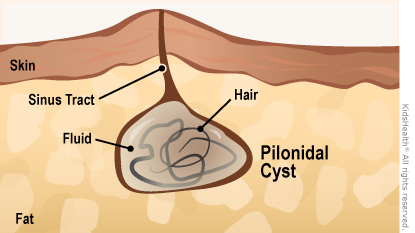A pilonidal (pie-luh-NIE-dul) cyst is a fluid-filled sac just under the skin close to the tailbone (coccyx), near the crease of the buttocks. A cyst may not be visible or can look like a small pit or dimple in the skin. Some can swell and feel like a bump under the skin. Many won't cause any symptoms unless they get infected. An infected cyst can be red, swollen, or painful, and it can burst and drain fluid, blood, or pus.



Your child has:


What causes a pilonidal cyst? It's thought that most pilonidal cysts form when loose hair and dead skin cells get trapped beneath the skin. They get forced deeper into the skin by friction and pressure from things like long periods of sitting, tight clothing, or bicycling. The body's immune system treats the hair and dead skin cells as foreign, forming a cyst around them that fills with fluid.
Can a pilonidal cyst cause any problems? A pilonidal cyst may get infected and fill with pus. An infected pilonidal cyst, also called a pilonidal abscess, can be painful, red, and swollen. It may drain pus or blood onto the skin through an opening called a sinus tract. It can also cause a fever.
How is a pilonidal cyst treated? A cyst that doesn't cause symptoms might not need treatment other than removing hair and keeping the area clean. If it causes symptoms, a health care provider might: